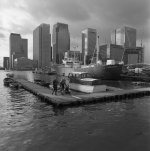Hi Victor,
If you are not going to use flash very often, I would recommend the SQ-A. See the following link for more details on the different Bronica SQ models:
http://www.tamron.com/bronica/sq_guide.asp
You are correct about the SQ-B, it was only sold as a kit and was a stripped down version of the SQ-Ai. It has no contact points in the viewfinder area, so even if you mount a metered viewfinder on the SQ-B, it won't give you any meter reading.
I have the SQ-A with waist level finder, 120 back, and 80mm normal lens, 40mm wide angle lens and 250mm tele lens. Any of these lenses will give you very sharp pictures. The 40mm I have has a built-in lens hood, I understand that there was a second version without a built-in lens hood. The only downside about the built-in lens hood is the impossibility to use resin filters on it, you have to buy some relatively expensive screw in filters if you want to seriously explore black and white. Filter diameter of the 40mm is 95mm, which makes these filters rather expensive and difficult to locate. The 80mm and 250mm take the standard 67mm filters.
Try and get the 120 film back. There was also the option to buy a 220 film back, but 220 film is getting more difficult to buy these days. Mind that the backs come with a dark slide, it's a piece of metal that you can slip into the back, so that you can take the back off midroll. Interesting if you want to shoot the same scene in colour and in black and white, or if you need to load a quicker film for a particular picture. Many second hand backs come without this dark slide and they are very difficult to locate on their own.
The waist level finder is more than adequate for landscape and portrait, but you have to take into account that you will get a laterally inversed image: what is on the left in real life will show up on the right in the viewfinder. No problem with non moving subjects and with the camera on a tripod. You can always buy an additional prism (metered or not) in the future if you want to do a different type of photography.
I bought my camera and lenses second hand around 1990 and they have never let me down. For maximum sharpness in landscape shots, make sure to use the mirror lock up before each picture, as the large mirror will give some vibration at slower speeds.
If at all possible, try to buy the camera body, 120 back, viewfinder (WL or other) and 80mm lens from the same seller. And get the original front and back lens caps if possible. A nice add on are the original lens cases and instruction book for the camera. Also, ask the seller some basic questions and if you get a helpful and quick answer, you are usually dealing with a thrustworthy seller. There are a lot of sellers on Ebay who only resell what they have been able to find in garage sales etc. and know virtually nothing about what they are selling. Ask the seller when he or she used the camera for the last time. Don't fall for the usual comment "I have no battery or film for this camera, so I have been unable to test it". Any photographer selling off his equipment won't mind putting a test roll through the camera to assure a possible buyer that everything is working correctly.
Regards
Jan






